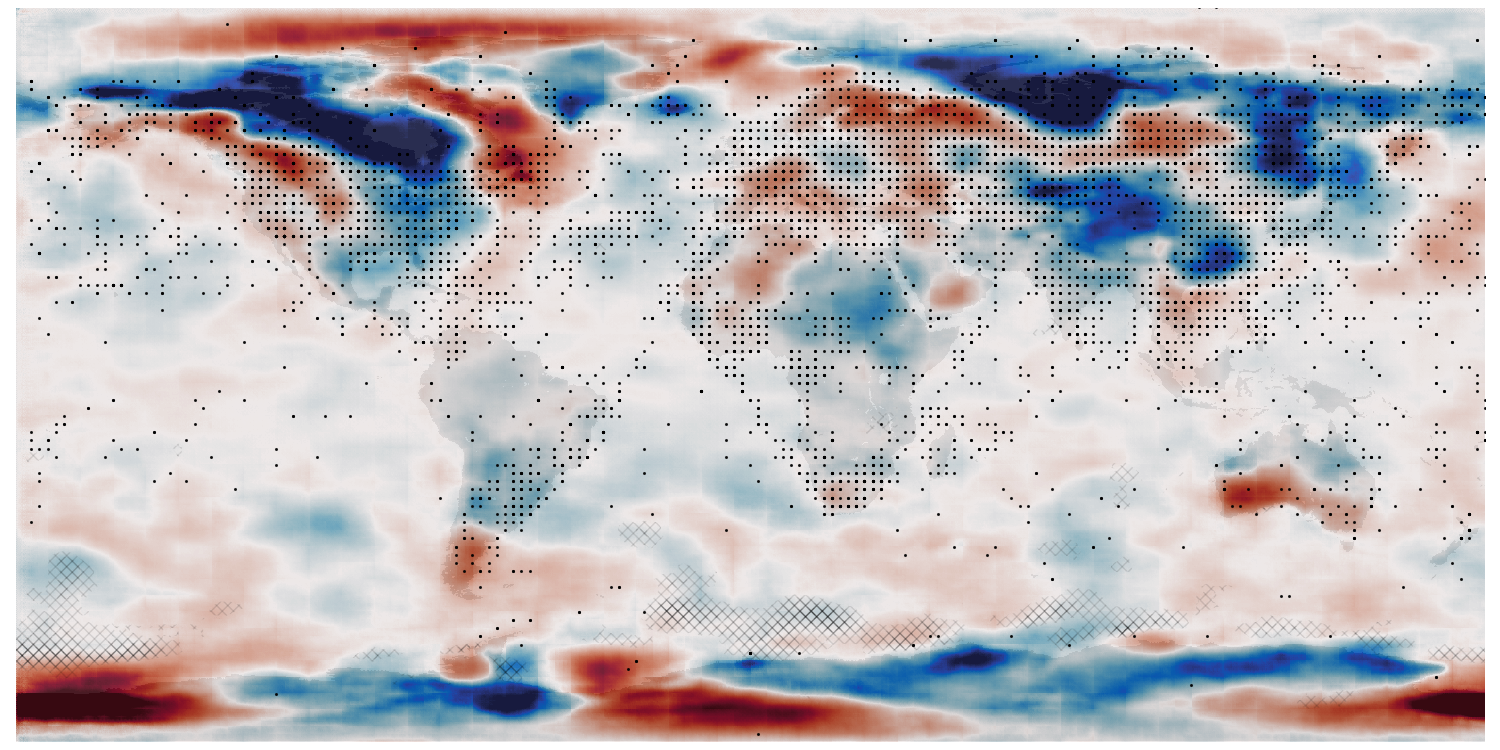Pressure from wind - validate the trained VAE¶

VAE validation: Red contours are from the input dataset, blue contours show generator output. The three rows are the variables: mslp - top, u10m - middle, v10m - bottom. The left hand column shows comparisons of a case from the training dataset, the middle column a case from the test dataset, and the right hand column an example of generator output.¶
Script to make the validation figure
#!/usr/bin/env python
# Plot a validation figure for the autoencoder.
# Three tests:
# 1) Sample from the training dataset
# 2) Sample from the test dataset
# 3) Generated samples from random point in the latent space
#
import tensorflow as tf
import os
import sys
import random
import matplotlib
from matplotlib.backends.backend_agg import FigureCanvasAgg as FigureCanvas
from matplotlib.figure import Figure
import argparse
parser = argparse.ArgumentParser()
parser.add_argument("--epoch", help="Epoch", type=int, required=False, default=25)
args = parser.parse_args()
sys.path.append("%s/." % os.path.dirname(__file__))
from plot_prmsl_comparison import get_land_mask
from plot_prmsl_comparison import plot_PRMSL
from plot_prmsl_comparison import plot_scatter
# Load the data source provider
sys.path.append("%s/../../PUV_dataset" % os.path.dirname(__file__))
from makeDataset import getDataset
trainingData = getDataset(purpose="training")
testData = getDataset(purpose="test")
# Set up the model and load the weights at the chosen epoch
sys.path.append("%s/.." % os.path.dirname(__file__))
from autoencoderModel import DCVAE
autoencoder = DCVAE()
weights_dir = ("%s/Proxy_20CR/models/DCVAE_single_PUV/" + "Epoch_%04d") % (
os.getenv("SCRATCH"),
args.epoch,
)
load_status = autoencoder.load_weights("%s/ckpt" % weights_dir)
# Check the load worked
load_status.assert_existing_objects_matched()
margin = 0.05
f_width = (margin * 5 / 8) * 4 + 3 + 3 + 2
f_height = margin * 4 + 3
s_width = 1 / f_width
s_height = 1 / f_height
m_width = (margin * 5 / 8) / f_width
m_height = margin / f_height
fig = Figure(
figsize=(f_width, f_height),
dpi=250,
facecolor=(0.88, 0.88, 0.88, 1),
edgecolor=None,
linewidth=0.0,
frameon=False,
subplotpars=None,
tight_layout=None,
)
canvas = FigureCanvas(fig)
ax_global = fig.add_axes([0, 0, 1, 1], facecolor="white")
lm = get_land_mask()
# Plot a random example from the training dataset
count = 0
rnd = random.randint(1, 2567)
for t_in in trainingData:
if count == rnd:
encoded = autoencoder.sample_call(tf.reshape(t_in, [1, 80, 160, 3]), size=15)
for tp in range(3): # Each variable
ax_plot = fig.add_axes(
[m_width, 1 - (m_height + s_height) * (tp + 1), 2 * s_width, s_height]
)
ax_plot.set_aspect("auto")
ax_plot.set_axis_off()
plot_PRMSL(
ax_plot,
t_in[:, :, tp],
encoded[:, :, :, :, tp],
land=lm,
label="%d, %s" % (count, ("mslp","uwnd.10m","vwnd.10m")[tp]),
linewidths=[0.2, 0.05],
d_min=-0.25,
d_max=1.25,
c_space=0.1,
)
ax_scatter = fig.add_axes(
[
m_width + 2 * s_width,
1 - (m_height + s_height) * (tp + 1),
s_width,
s_height,
]
)
ax_scatter.set_aspect("auto")
ax_scatter.set_axis_off()
plot_scatter(
ax_scatter,
t_in[:, :, tp],
encoded[:, :, :, :, tp],
d_min=-0.25,
d_max=1.25,
)
break
count += 1
# Plot one random example from the test data set:
count = 0
rnd = random.randint(1, 256)
for t_in in testData:
if count == rnd:
encoded = autoencoder.sample_call(tf.reshape(t_in, [1, 80, 160, 3]), size=15)
for tp in range(3): # Each variable
ax_plot = fig.add_axes(
[
m_width * 2 + 3 * s_width,
1 - (m_height + s_height) * (tp + 1),
2 * s_width,
s_height,
]
)
ax_plot.set_aspect("auto")
ax_plot.set_axis_off()
plot_PRMSL(
ax_plot,
t_in[:, :, tp],
encoded[:, :, :, :, tp],
land=lm,
label="%d, %s" % (count, ("mslp","uwnd.10m","vwnd.10m")[tp]),
linewidths=[0.2, 0.05],
d_min=-0.25,
d_max=1.25,
c_space=0.1,
)
ax_scatter = fig.add_axes(
[
m_width * 2 + 5 * s_width,
1 - (m_height + s_height) * (tp + 1),
s_width,
s_height,
]
)
ax_scatter.set_axis_off()
plot_scatter(
ax_scatter,
t_in[:, :, tp],
encoded[:, :, :, :, tp],
d_min=-0.25,
d_max=1.25,
)
break
count += 1
# Plot one example of a generated field
eps = tf.random.normal(shape=(1, autoencoder.latent_dim))
generated = autoencoder.decode(eps)
for tp in range(3): # Each time-slice
ax_plot = fig.add_axes(
[
m_width * 3 + 6 * s_width,
1 - (m_height + s_height) * (tp + 1),
2 * s_width,
s_height,
]
)
ax_plot.set_aspect("auto")
ax_plot.set_axis_off()
plot_PRMSL(
ax_plot,
None,
generated[:, :, :, tp],
land=lm,
label="Generator %s" % ("mslp","uwnd.10m","vwnd.10m")[tp],
linewidths=[0.5, 0.5],
d_min=-0.25,
d_max=1.25,
c_space=0.1,
)
fig.savefig("comparison.png")
Utility functions used in the plot
# Functions to plot PRMSL before and after autoencoding
# Takes data in tensorflow format (no geometry metadata, normalised)
import os
import sys
import iris
import numpy as np
import tensorflow as tf
import matplotlib
import cmocean
sys.path.append("%s/../../../lib/" % os.path.dirname(__file__))
from geometry import to_analysis_grid
# It's a spatial map, so want the land mask
def get_land_mask():
mask = iris.load_cube(
"%s/fixed_fields/land_mask/opfc_global_2019.nc" % os.getenv("DATADIR")
)
return to_analysis_grid(mask)
def plot_PRMSL(
ax,
t_in,
t_out,
obs=None,
obs_c="black",
obs_cmap="RdBu",
land=None,
label=None,
d_max=1,
d_min=0,
c_space=0.3,
linewidths=[1, 1, 1],
):
if land is None:
land = get_land_mask()
lats = land.coord("latitude").points
lons = land.coord("longitude").points
land_img = ax.pcolorfast(
lons, lats, land.data, cmap="Greys", alpha=0.3, vmax=1.2, vmin=-0.5, zorder=10
)
# 20CR2c data
if t_in is not None:
t_in = tf.squeeze(t_in)
if tf.rank(t_in) == 2:
t_in = tf.expand_dims(t_in, axis=0)
t_list = tf.unstack(t_in, axis=0)
for t_in in t_list:
CS = ax.contour(
lons,
lats,
t_in.numpy(),
colors="red",
linewidths=linewidths[0],
linestyles="solid",
alpha=1.0,
levels=np.arange(d_min, d_max, c_space),
zorder=20,
)
# Encoder output
if t_out is not None:
t_out = tf.squeeze(t_out)
if tf.rank(t_out) == 2:
t_out = tf.expand_dims(t_out, axis=0)
t_list = tf.unstack(t_out, axis=0)
for t_out in t_list:
CS = ax.contour(
lons,
lats,
t_out.numpy(),
colors="blue",
linewidths=linewidths[1],
linestyles="solid",
alpha=1.0,
levels=np.arange(d_min, d_max, c_space),
zorder=30,
)
# Observations
if obs is not None:
obs = tf.squeeze(obs)
ax.scatter(
(obs[:, 1].numpy() / 160) * 360 - 180,
(obs[:, 0].numpy() / 80) * 180 - 90,
s=3.0 * linewidths[2],
c=obs_c,
cmap=obs_cmap,
marker="o",
alpha=1.0,
zorder=10,
)
ax.text(
-175,
-85,
label,
horizontalalignment="left",
verticalalignment="bottom",
color="black",
bbox=dict(
facecolor=(0.8, 0.8, 0.8, 0.8), edgecolor="black", boxstyle="round", pad=0.5
),
size=4,
clip_on=True,
zorder=40,
)
def plot_scatter(ax, t_in, t_out, d_max=3, d_min=-3):
ax.set_xlim(d_min, d_max)
ax.set_ylim(d_min, d_max)
t_in = tf.squeeze(t_in)
if tf.rank(t_in) != 2:
raise Exception("Unsupported input data shape")
t_out = tf.squeeze(t_out)
if tf.rank(t_out) == 2:
t_out = tf.expand_dims(t_out, axis=0)
t_list = tf.unstack(t_out, axis=0)
hb_in = None
hb_out = None
for t_out in t_list:
if hb_in is None:
hb_in = t_in.numpy().flatten()
hb_out = t_out.numpy().flatten()
else:
hb_in = np.concatenate((hb_in, t_in.numpy().flatten()))
hb_out = np.concatenate((hb_out, t_out.numpy().flatten()))
ax.hexbin(
x=t_in.numpy().flatten(),
y=t_out.numpy().flatten(),
cmap=cmocean.cm.ice_r,
bins="log",
mincnt=1,
)
ax.add_line(
matplotlib.lines.Line2D(
xdata=(d_min, d_max),
ydata=(d_min, d_max),
linestyle="solid",
linewidth=0.5,
color=(0.5, 0.5, 0.5, 1),
zorder=100,
)
)
ax.set(ylabel="Original", xlabel="Encoded")
ax.grid(color="black", alpha=0.2, linestyle="-", linewidth=0.5)
